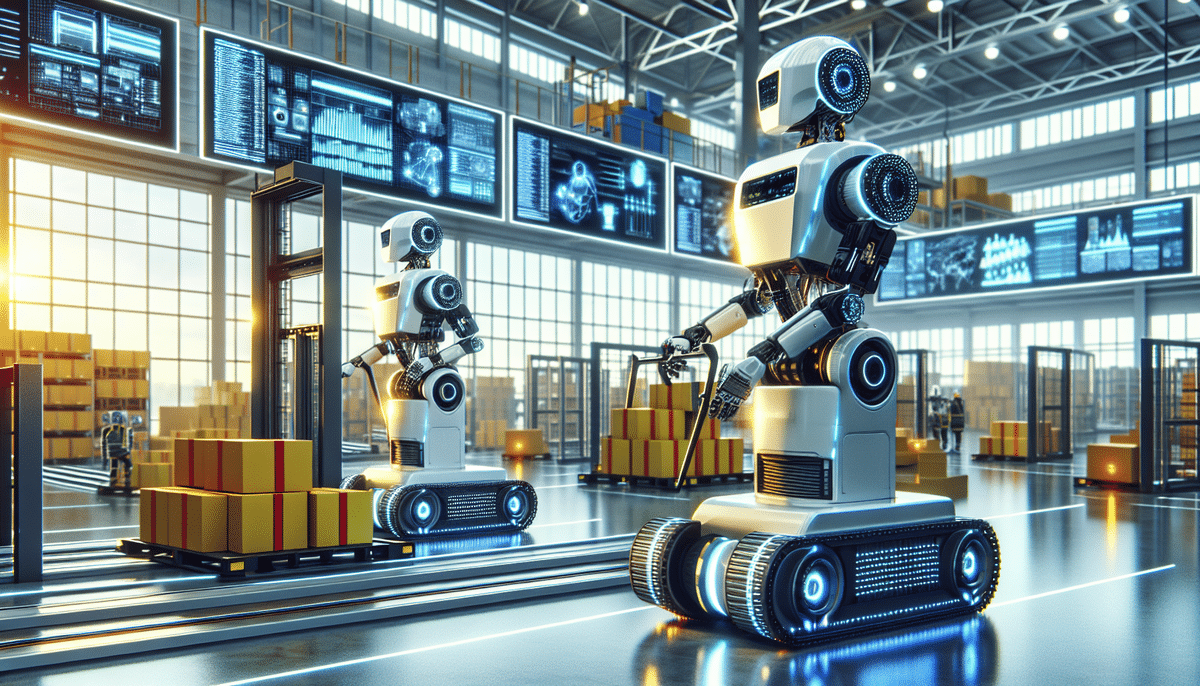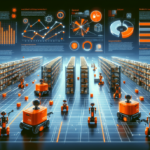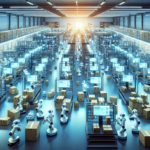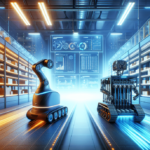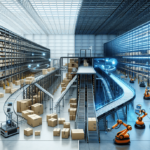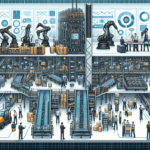Kiva Systems (Amazon Robotics) vs GreyOrange: A Comprehensive Comparison
Warehouse automation has significantly advanced in recent years, with Kiva Systems (now known as Amazon Robotics) and GreyOrange leading the industry in technology and innovation. While both companies offer cutting-edge automation solutions, they differ markedly in their approaches, implementation strategies, and cost structures. This article provides an in-depth overview of Amazon Robotics and GreyOrange, compares their strengths and weaknesses, and examines real-world case studies to help businesses determine the best fit for their needs.
The Evolution of Warehouse Automation
Understanding the evolution of warehouse automation is crucial before delving into the specifics of Amazon Robotics and GreyOrange. Historically, warehouses depended heavily on manual labor and paper-based tracking systems for inventory management. However, the integration of sophisticated software and robotics has revolutionized warehouse operations, enabling faster inventory processing, reducing errors, and enhancing overall efficiency.
According to a Gartner report, the warehouse automation market is projected to grow by 15% in 2023, driven by the surging demand in e-commerce and the need for operational efficiency. The earliest forms of warehouse automation included conveyor belts introduced in the early 20th century, which transformed goods transportation within warehouses. The 1960s saw the integration of computer technology into warehouse management systems, allowing for advanced inventory tracking and control, as well as the automation of tasks such as order picking and packing. Today, artificial intelligence and machine learning continue to push the boundaries of warehouse automation, promising even greater advancements and efficiencies.
Overview of Amazon Robotics and GreyOrange
Amazon Robotics
Amazon Robotics offers automation solutions focused on material handling and order fulfillment. Their robotic drive units are designed to transport inventory seamlessly within facilities, minimizing the need for manual labor. Utilizing complex algorithms, Amazon Robotics optimizes the paths of each drive unit to enhance efficiency and reduce collision risks. This solution is particularly beneficial for businesses aiming to automate high-volume e-commerce operations.
One of Amazon Robotics' key strengths is the flexibility of their system, which can be customized to meet the specific needs of different businesses, ensuring seamless integration with existing workflows. Additionally, the scalability of Amazon Robotics' solutions makes them suitable for businesses planning to expand their operations in the future.
GreyOrange
Conversely, GreyOrange provides a diverse range of automation solutions, including robotic goods-to-person (GTP) systems and mobile robots. GreyOrange's GTP systems employ autonomous robots to deliver items directly to human operators for picking and packing, while their mobile robots facilitate inventory movement with minimal human intervention. These solutions are ideal for businesses seeking to enhance warehouse efficiency and expedite order fulfillment processes.
GreyOrange excels in advanced analytics capabilities. Their software integrates data from various sources, including sensors and cameras, providing real-time insights into warehouse operations. This allows businesses to identify bottlenecks and inefficiencies, enabling data-driven decision-making to optimize processes.
Key Similarities and Differences
Similarities
- Both utilize advanced software and algorithms to optimize warehouse operations and enhance efficiency.
- Their solutions are designed to be scalable and adaptable to various warehouse sizes and layouts.
- Amazon Robotics and GreyOrange prioritize safety and reliability, ensuring their systems operate smoothly and without disruptions.
Differences
- Approach to Automation: Amazon Robotics relies on robotic drive units for inventory transportation, whereas GreyOrange emphasizes autonomous picking and packing processes.
- Cost Structure: Amazon Robotics tends to be more expensive, though both companies offer various pricing options to suit different budgets.
- Implementation Strategy: Amazon Robotics provides highly customizable and scalable solutions, while GreyOrange focuses on integrating advanced analytics for real-time operational insights.
Implementation Process
Amazon Robotics
Implementing Amazon Robotics' solutions involves deploying a team of specialists who collaborate closely with businesses to design and scale systems tailored to their specific needs. Comprehensive training programs ensure that businesses can effectively operate and maintain their new systems.
GreyOrange
GreyOrange employs experts to help businesses design and deploy solutions that integrate seamlessly with existing workflows. Extensive training and ongoing support are provided to help businesses maximize the benefits of their automation solutions.
Customization: Both companies offer a range of customization options, from software configuration to hardware integration, allowing businesses to tailor their automation solutions to their unique requirements.
Strengths and Weaknesses
Amazon Robotics
Strengths:
- Highly efficient and reliable systems.
- Advanced algorithms for optimal inventory transportation.
- Scalability and flexibility for future expansion.
Weaknesses:
- High initial cost of solutions.
- Potential challenges in integrating technology into existing workflows.
GreyOrange
Strengths:
- More affordable solutions compared to Amazon Robotics.
- Easy implementation and flexibility to work alongside human operators.
- Advanced analytics for real-time operational insights.
Weaknesses:
- May not achieve the same level of efficiency as Amazon Robotics.
- GTP systems might require substantial changes to existing workflows.
Real-World Case Studies
Amazon Robotics
A high-volume e-commerce retailer implemented Amazon Robotics' solutions and reduced fulfillment time from hours to minutes, significantly enhancing efficiency and customer satisfaction. This case study highlights the potential for substantial improvements in order processing speed and accuracy.
GreyOrange
A leading fashion retailer increased their throughput by 300% using GreyOrange's GTP system, demonstrating the scalability and effectiveness of GreyOrange's solutions in handling large volumes of inventory and orders.
The Future of Warehouse Automation
The competition between Amazon Robotics and GreyOrange underscores the growing importance of warehouse automation in today’s economy. As more businesses seek to automate their operations, the demand for warehouse automation solutions continues to rise. Both Amazon Robotics and GreyOrange are well-positioned to capitalize on this trend, offering state-of-the-art solutions that significantly enhance warehouse productivity and efficiency.
Labor Cost Reduction: Automating repetitive tasks allows businesses to decrease the need for manual labor, allocate resources to more complex tasks that require human expertise, and reduce the risk of human error.
Inventory Management Optimization: Automated systems can track inventory levels in real-time, enabling businesses to make informed decisions about restocking and minimizing the risk of stockouts. This leads to improved customer satisfaction and increased revenue.
According to a Forbes article, the integration of AI and machine learning will further enhance the capabilities of warehouse automation systems, leading to even greater efficiencies and smarter decision-making.
Cost Comparison
Amazon Robotics and GreyOrange differ significantly in terms of cost. Amazon Robotics' solutions tend to be more expensive, although the total cost of ownership can vary depending on facility size and solution complexity.
Factors Influencing Cost:
- Facility Size: Larger facilities may benefit more from scalable solutions offered by Amazon Robotics.
- Solution Complexity: More complex automation needs can drive up costs for both companies, though GreyOrange may offer more affordable customization options.
- Customization: Amazon Robotics offers standardized solutions that might be less expensive upfront, while GreyOrange provides customizable options that may involve higher initial costs.
It's important to consider the total cost of ownership, including ongoing maintenance and support. Both companies offer maintenance and support services, but the specifics should be carefully evaluated based on business needs.
Customer Reviews
Customer reviews are invaluable for businesses deciding between Amazon Robotics and GreyOrange.
Amazon Robotics
Reviews for Amazon Robotics' solutions are predominantly positive, with customers praising the system's efficiency, reliability, and scalability. Many users highlight the significant reduction in fulfillment times and the seamless integration with existing workflows.
GreyOrange
Reviews for GreyOrange's solutions also highlight the ease of implementation and system flexibility. Customers appreciate the advanced analytics and real-time insights provided by GreyOrange, though some note longer wait times for customer support compared to Amazon Robotics.
Prospective customers should consider their specific needs and preferences, as experiences may vary based on individual use cases.
Impact of COVID-19 on Warehouse Automation Adoption
The COVID-19 pandemic underscored the critical importance of warehouse automation, as businesses sought to reduce human contact and minimize infection risks. The pandemic also fueled a surge in e-commerce demand, placing additional pressure on warehouses to process orders swiftly and efficiently.
Both Amazon Robotics and GreyOrange are well-equipped to meet this increased demand, offering solutions that enhance productivity and reduce reliance on manual labor. According to a McKinsey report, companies that invested in automation during the pandemic experienced significant improvements in operational resilience and scalability.
In conclusion, Amazon Robotics and GreyOrange are both leaders in the warehouse automation sector, providing state-of-the-art solutions that can significantly enhance productivity and efficiency. While each company has its unique strengths and weaknesses, businesses that adopt warehouse automation can expect substantial improvements in their operations. By leveraging advanced technology and robotics, businesses can streamline processes, reduce errors, and elevate overall customer satisfaction.















